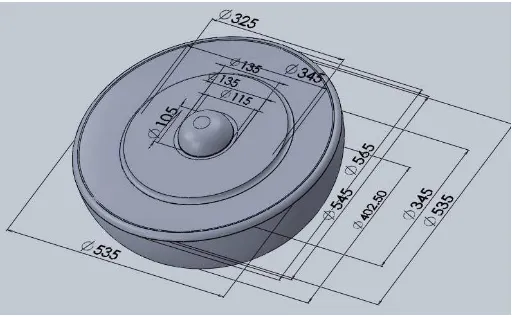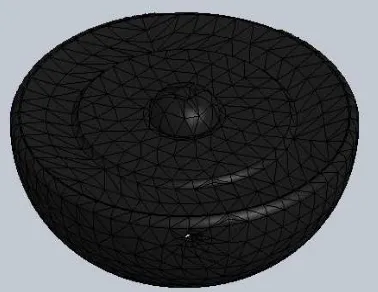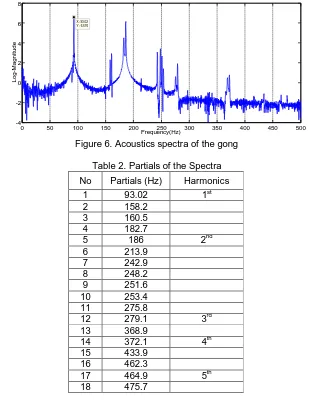Javanese Gong Acoustics and Its Modeling using Finite
Element Method
Gunawan Dewantoro*, Matias H.W. Budhiantho
Department of Electronics and Computer Engineering, Satya Wacana Christian University Diponegoro Street 52-60, Salatiga, Indonesia
*Corresponding author, e-mail: [email protected]
Abstract
In Central Java, the Javanese Gong is one of prominent gamelan instrument to mark the end of musical passage. The Gong is a distinctive percussion instrument because of its wave-like sounds after being struck immediately due to its traditional manufacture procedures. Spectra for the gongs vary substantially due to variation in shape and size, and to dimensional irregularities created during manufacture and whilst tuning by soft-hammering or hand-grinding. Finite Element Analysis is used to predict the effect of a range of variations of gong geometries on modal shapes as well as modal frequencies. The radiated sound spectra of the gong are also measured and compared with the natural frequencies obtained from Finite Element Analysis. Through the finite element model, the effect of geometric dimensions and material properties of the gong on its sound characteristics can be predicted.
Keywords: Javanese gong, modal frequencies, mode shapes, finite element method, acoustic spectra
Copyright © 2015 Institute of Advanced Engineering and Science. All rights reserved.
1. Introduction
The Javanese Gong plays an important role in Javanese culture. In gamelan music ensemble, gong sound marks and ends certain passage of a gamelan composition [1]. The gong sound is also used to declare the opening and closing of important religious and secular events or various rituals. The roaring wavelike sound of the gong is associated by Javanese with Bima’s giggle that creates a grandeur yet calming feeling. Bima is known as a bold but honest and just hero, a great legend in Javanese puppet shadow (wayang) stories. The number of wavelike sound repetition cycles in a best sounding gong can be as many as 12 to 13. A Gong is still traditionally handmade by casting, hammering, forging and tuning as well. In this research we studied the 56 cm diameter of iron Gong Kempul, a second largest gong in the complete set of Javanese Gamelan instrument. Although an iron gong is less expensive kind of gong that is mainly used for educational purposes, it is still crafted to produce the wavelike sound. The gong was tuned to tone 6 in pelog scale [1]&[2].
Analysis experiment for gong models did not match the acoustic spectra for these gongs. Lu [8] presented a study of the vibrational behaviour of the violin top plate and explored the possibility of using composite materials as a substitute for traditional wood in making top plates. Numerical simulations and experimental tests are compared to validate the results. The two most popular methods for numerical and experimental vibrational analysis, the Finite Element Method (FEM) and Experimental Modal Analysis are used, respectively. Then, the same modeling and testing techniques were applied on two composite plates. Results show that the vibrational behavior of composite plates differs significantly from traditional wooden plates. Facchinetti et al. [9] applied finite element analysis (FEA) and experimental mode analysis (EMA) to study the vibration behaviors of reed and pipe in clarinet. The holographic interferometer was used to observe the vibration modes and eigen-frequencies of the reed. The experimental results showed that some reeds had strong asymmetries; the cause of modal asymmetries lies most probably in the lack of homogeneity of the cane used for the reed due to its natural character. To understand the vibration behavior of musical instruments and their sound mechanism, experimental techniques are necessary. Wang [10] presented the approach of virtual testing (VT) by the integration of finite element analysis (FEA) and experimental modal analysis (EMA) techniques for the design analysis of several types of percussion instruments. First, the procedure for model verification is introduced and shown the basic principle for validating the finite element model by adopting FEA software and performing EMA. The sound spectrum of percussion instrument can then be measured to identify the most contributed structural modes and compared with those modal parameters obtained from FEA and EMA. Three types of percussion instruments, including a xylophone bar, a metallophone plate and a gong, are shown to demonstrate the idea of VT for the redesign of new type of percussion instruments. Skrodzka and Sek [11] adopted the traditional experimental modal analysis techniques to get modal frequencies, modal damping ratios, and their corresponding mode shapes of a loudspeaker under different working conditions. The vibration frequencies and the mode shapes for a semi-cone woofer and a tweeter were observed. Finite element analysis modeling has been applied to the design of novel idiophones for use within conventional European musical contexts [12]. Computer programs which physically model musical instruments through FEA modeling have recently been developed for electronic music synthesis [13]. This work adopts FEA to study the vibration characteristics of an iron Gong Kempul. It is made of malleable cast iron, with material properties as follow: elastic modulus of 1.9e11 Pa, poisson’s ratio of 0.31, mass density of 7200 kg/m3, tensile strength of 861e6 Pa, and yield strength of 827e6 Pa. Figure 1 shows the design of the gong and its dimensions. The sound frequency response is also measured to find the relationship between the dynamic modes and sound qualities. From the FEA model, the effect of geometry dimensions and material properties on the principal frequency is also observed.
Figure 1. Dimension of gong kempul in millimeters
2. Finite Element Analysis in Solidworks
SolidWorks Standard. It improves of the efficiency and innovating with solutions that are used by millions of designers. It contains additional extension modules as Animator, PhotoWorks, etc. The SolidWorks Premium is the most comprehensive software. It combines the capabilities of the SolidWorks Professional with simulations. The Part of the SolidWorks Professional is the SolidWorks Simulation, which provides basic simulation tools for testing stress, strain, analyzing the kinematics, dynamics and it simulations conditions of the real world [14].
2.1. Boundary Condition
The material properties are assigned to the gong and boundary conditions are defined. The beam’s all degrees of freedom on surface are taken. They are denoted with the green flag in Figure 2. These two holes are fixtures through which hanging ropes hold the gong. This condition prevents the movement of the surface in a space.
Figure 2. Boundary condition
2.2. Mesh Configuration
Mesh on the beam is generated automatically by SolidWorks. The element is defined by 10 nodes while each node has three degrees of freedom at each node. The spatial element has 16 Jacobian points and is suitable for modeling of the finite element irregular mesh. The maximum size of the element is 33.8607 mm with tolerance of 1.69 mm. The mesh in Figure 3 is created of 8523 elements and of 17026 nodes.
2.3. Modal Analysis of Gong
The modal analysis is carried out by SolidWorks and mode shapes and natural frequencies are also calculated. For this modal analysis the direct solver including the FFEPlus method is used. The first five mode shapes are shown in Figure 4, and the first five natural frequencies are shown in Table 1.
(a) (b) (c)
(d) (e)
Figure 4. Mode shapes of gong: (a) First Mode (b) Second Mode (c) Third Mode (d) Fourth Mode (e) Fifth Mode
Table 1. Natural Frequencies of Particular Mode Shapes
Mode shape 1 2 3 4 5
Frequency (Hz) 78.506 224.74 344.2 397.84 533.53
3. Acoustics Spectra of the Gong
We recorded 48kHz sample tones of the Gong Kempul using ARTA PC Software. A controlled gong striker was utilized to exert a controlled impact force upon the gong boss, as seen in Figure 5. First, a measurement condenser microphone acquired the acoustic signal by near field measurement from behind of the boss, externally powered by a phantom power. A sound card then interfaced and digitized this signal in order that computers are able to recognize.
An impulse-generated response was recorded to analyze in both the time and frequency domain as shown in Figure 6. The spectral peaks indicate partials with significant strength. Table 2 shows the 18 consistent partials, averaged from four trials, of the gong consisting of both harmonis and nonharmoic frequencies [15]. The partials at 93.02 Hz, 186 Hz, 279.1, 372.1, and 464.9 Hz are the strict integer multiples of the fundamental frequency. Hence, these partials are the first, second, third, fourth, and fifth harmonics, respectively. Such degree of harmonicity of the partials leads to the pitched sound of the Gong Kempul, differing it from that of Chinese gongs which sound like a crash. The harmonic and or inharmonic partials that occur in fairly close frequency beat together and form the roaring sound which is often
Table 3. Differences between predicted and measured natural frequencies (Hz)
Mode 1 2 3 4 5
FEA 78.506 224.74 344.2 397.84 533.53
Spectra 93.02 186 279.1 372.1 464.9
Absolute Error (%) 15.6 20.82 23.32 6,91 14.7
As shown in Table 3, the predicted frequencies of the finite element analysis experiments for gong model based on manufactured gongs did not match the acoustics spectra
for these gongs due to various effects of the manufacturing processes which are difficult to accurately model. The gong makers are used to mix the raw material, composed by tin and copper, with a certain ratio. Besides, they fine-tune the gong using soft hammer by tapping the outer part of boss, therefore, there are many irregularities from one gong to another gong.
For more understanding of the geometric dimensions and material properties’ effects on the sound characteristics of the gong, finite element models are created with different properties. Table 4 lists natural frequencies for different cases. The first modification doubles the thickness from 5 mm to 10 mm, whereas, the second modification change the gong material to copper-tin alloy with elastic modulus of 1.1e011 Pa, Poisson’s ratio of 0.33, and mass density of 8300 kg/m^3.
Table 4. Natural frequencies (Hz) for different properties
Mode Original case Double size of
thickness frequencies as that found in gamelan set for both pelog and slendro scale. However, increasing the thickness of the gong will result in higher natural frequencies. For lower stiffness material, the natural frequencies are lower than those of for higher stiffness material.
4. Conclusion
In this study, the finite element model of a Javanese gong is constructed. The sound characteristics of the copper gong are also investigated. The result obtained from finite element analysis show much difference since there are many concavities and convexities on the surface of the gong resulting from traditional manufacturing especially during fine-tuning process. In finite element analysis, structural dimensions and material properties of the gong can be changed to better understand the effect in vibration behavior and sound characteristics. Through these analyses, the gong structure can be modified to improve its sound characteristics. In future, an experimental modal analysis needs to be carried out to verify the model generated using finite element method.
Acknowledgement
This research is financially supported by Satya Wacana Christian University under Competitive Grant Scheme no. 045/Penel./Rek./5/II/2014
Reference
[1] Palgunadi B, Serat Kandha Karawiran Jawi, Bandung: ITB Publisher. 2002.
[2] Hood KM, Music of The Roaring Sea: The Evolution of Javanese Gamelan, Wilhelmshaven: Heinrichshofen, 1980.
[3] Tsai GC, Wang BT, Lee YS, Chang ZW. Study of Vibration and Sound Characteristics of A Copper Gong. Journal of the Chinese Institute of Engineers. 2005: 28 (4): 713-719.
[4] Yusoff NAM, Karim KA, Ghani SA, Sutikno T, Jidin A. Multiphase Transformer Modelling using Finite Element Method. International Journal of Power Electronics and Drive System. 2015: 6 (1): 56-64. [5] George K, Shinoy KS, Gopinathan A. Finite Element Modeling of Five Phase Permanent Magnet
BLDC Motor for High Power Density Application. International Journal of Power Electronics and Drive
System. 2013: 3 (4): 384-390.
[6] Bretos J, Santamaria C, Moral JA. Vibrational Patterns and Frequency Responses of the Free Plates and Box of a Violin Obtained by Finite Element Analysis. Journal of Acoustical Society of America. 1999: 105 (3): 1942-1950.
[7] Maclachlan N. Finite Element Analysis and Gong Acoustics. Acoustics Australia. 1997: 25 (3): 103-107.
[9] Facchineti ML, Boutilion X, Constantinescu A. Numerical and Experimental Modal Analysis of the Reed and Pipe of a Clarinet. Journal of Acoustical Society of America. 2003: 113 (5): 2874-2833. [10] Wang BT. Integration of FEA and EMA Techniques for Percussion Instrument Design Analysis.
International Conference on System Science and Engineering. Macao. 2011: 11-16.
[11] Skrodzka E, Sek A. Comparison of Modal Parameters of Loudspeakers of Different working Conditions. Applied Acoustics. 2000: 60 (3): 267-277.
[12] Fletcher NH. Tuning a Pentangle-A New Musical Vibrating Element. Applied Acoustics. 1993: 39 (1): 145-163.
[13] Djoharian P. Generating Models for Modal Synthesis. Computer Music Journal. 1993: 17 (1): 57-65. [14] Lengvarsky P, Bocko J, Hagara M. Modal Analysis of a Titan Cantilever Beam using ANSYS and
Solidworks. American Journal of Mechanical Engineering. 2013: 1 (7): 271-275.
[15] Budhiantho MHW, Dewantoro G. The Spectral and Temporal Description of Javanese Gong Kempul. International Conference on Information Technology and Electrical Engineering. Yogyakarta. 2013: 300-304.
[16] Budhiantho MH, Dewantoro G. Javanese Gong Wave Signals. Proceedings of Meetings on Acoustics. San Francisco. 2014: 1-8.



